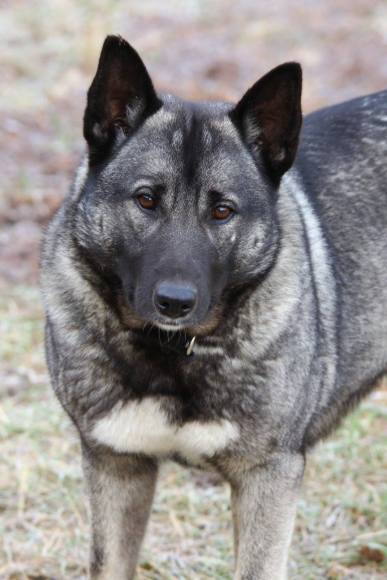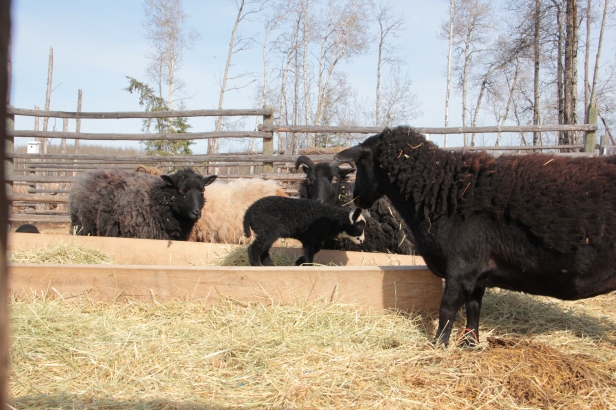Most people that I have ever talked to about sheep have said the same thing: sheep are dumb.
Sheep can be frustrating.
They can be stubborn.
They are escape artists.
But I have not experienced them to be dumb.
We acquired our first 5 sheep from some friends when we first moved on to our property. They were free, so I said yes.
Which brings us to the first thing that our venture taught us about having animals: be prepared before you get them. By this, I mean as prepared as you can be. Animals, especially species that you have never worked with before, will always throw you some kind of a curveball. But you should have a general idea of what you are getting in to. And of how to keep them where you want them.
So our friends dropped off our sheep and we got them put into a pen and we thought we had it figured out. The kids named them wonderfully: Spotty Dottie, Piglet, Mama Lama, Joe, and Joe. They are a mix of dorper/katahdin x which means that they are hair sheep, not wool sheep. They are lower maintenance than wool sheep because their hair roos (pulls out or sheds) on its own and you don’t have to shear them.
What we weren’t prepared for is how a sheep can get out of just about anything. I’ve heard that with mice, if they can fit their head into something they can get through it. In this regard, sheep are just big, hairy mice.
They escaped so many times. Under our wooden rails, between them, through the metal bars of our gates, we just couldn’t keep them in. And putting them back was no easy feat either. It would take about 5 of us to corral them back into a stall. Or to move them to a new stall when the grass got too short. So, eventually, we stopped worrying about putting them away. We let them free range. And it was great because I didn’t have to mow more than once for the rest of the summer. And, like the nursery rhyme says, “leave them alone and they’ll come home.” Occasionally, I would wander the yard with a shovel and pick up or scatter the bigger piles of droppings, but all in all, it was working quite well. The sheep had a curious habit of finding just the slightest of rises or contours in our yard (about a 6″ rise) and they would all sleep on it. There are a couple of these rises around our yard and it always seemed like the sheep were attracted to those areas specifically. We grew quite accustomed to watching them roam the yard and have their pick of where to graze on any given day. They seemed content to find their own amusement. Once, because we all sleep in the basement, Dani was changing and looked up to see that she was being watched by one of the Joes. Another time, we had a sheep headbutt our window when he saw his reflection. Thankfully, he was fairly timid and didn’t do any damage.
So, the free range thing was working well, until we got Kya, our elkhound dog. Kya quickly claimed the yard and the sheep’s grazing radius began to expand. They moved out to the pasture, and eventually into the neighbor’s barley. Which wasn’t a hit. In the fall, when the crops came off, they started heading for the neighbor’s flower garden on occasion, and that was the end of free range sheep. We reinforced our paddocks and kept them more localized. We also began to incorporate the electric netting that I talked about in our post on chickens. The first time we used it, the dogs were close enough to make the sheep nervous and they went right over top/through it. The next time we kept the dogs away and used the fence to line the interior of their paddock so that they couldn’t go over it or through it and that worked like a charm. So we would set up our fence and then shake a pail of oats or soaked field peas and let them loose and they would follow us wherever we went. The faster I ran, the closer to me they’d stick.
And then winter came. We had some square bales left over in the barn so we started feeding them those, but they seemed to be hungry still. That’s when someone pointed out to me that they were straw bales. Not hay bales. The difference between straw and hay, for those of you who don’t know, is that hay is cut when the grass/alfalfa/other plants in the mix are green and full of nutrients. Then it cures and is baled up and it retains a lot of nutritional value. Straw is generally taken off of wheat or barley after all the nutrients have been used to form the grain and the grain has been harvested. Then, the stalks that are left are harvested as straw. Straw is good for bedding, but not for eating. So that’s why our sheep were hungry. And why I was embarrassed.
We got our sheep through the winter. Every night we would go out after dark and fork them some hay. It was a really special time, going out at night into the still, cold, darkness to feed something that depended on us. This is the first time I can remember feeling a real connection with an animal. I remember going out at Christmas, standing there with the sheep, looking at their little shelter/shed, and thinking about the Christmas story. I was overwhelmed with the sense that I was there.
At the end of the next summer we bought some more sheep. Shetlands. These small, dark-coloured little flying carpets were wild and starving. They are still wild, although a few of them are coming around. Shetland sheep are an unimproved (heritage) breed. They are great birthers and moms. They can survive on very poor pasture but will thrive on good grass. Their wool is beautiful and their meat is sweet. We did take a crack at shearing them this spring, just with the scissor-style hand shears, but we didn’t save any wool because it was all full or rose bushes. We will update our progress when we try our electric shears this coming spring.
Our 5 ewes birthed 9 lambs. We have sold the 5 ram-lambs this year for meat and are keeping the ewe-lambs for breeding. We are hoping for 9-18 lambs next spring and will be looking for buyers. I butchered two of the three rams that we bought at Easter and the meat was wonderful. And that was from 2-3 year old intact rams (called hogget). The reason that Shetlands are generally not raised for meat is because they are small, and in a world where the livestock is bred for a higher meat-input ratio, small animals aren’t generally valued.
So, how to end this? We have been frustrated a lot by our sheep. We have thought about selling them lots of times, pretty much every time we have had to catch them. But we have had some magic moments with them too. Like whenever they hear us leave the house and start calling to us for hay. Or when I am running as fast as I can through the pasture with 5 sheep hot on my heels. Or when we found our first little lamb in the barn right after Christmas. Or those starry nights pitching hay over the fence as the sheep jostle for position. Those sheep have been our introduction to livestock, and have been great teachers.

I love your sheep adventures! I have 4 sheep now – a old Suffolk cross ewe (Ruby), a Dorper/Khatadin cross ewe (Blossom). A Southdown wether (Barney) and a brand new 3-week old bottle ram lamb (Henry) who was sold to me as a ewe! It wasn’t until I got him home and he peed that I realized something was wrong with the picture! I also have goats (too many), donkeys, ducks , chickens cats and 2 lovely dogs. I would love to have a Shetland ewe as a pet, like the rest!
Good luck with your animal adventures!
Joyce
LikeLike